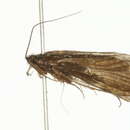Conservation Status
provided by University of Alberta Museums
Common.
- license
- cc-by-nc
- copyright
- University of Alberta Museums
Cyclicity
provided by University of Alberta Museums
Adults fly from mid-July to late September.
- license
- cc-by-nc
- copyright
- University of Alberta Museums
Distribution
provided by University of Alberta Museums
Alaska, south to Montana and Oregon. In Alberta, this species is largely confined to the foothills, with one record in Swan Hills as well (Nimmo, 1977).
- license
- cc-by-nc
- copyright
- University of Alberta Museums
General Description
provided by University of Alberta Museums
Adult antennae are deep yellow-brown with pale annular sutures. The vertex of the head is dark brown anteriorly, paling posteriorly. Segment 9 in males, dorsal-posterior edge is not developed posterad. The basal article of the clasper is deeply indented on the ventral edge (Nimmo, 1977).
- license
- cc-by-nc
- copyright
- University of Alberta Museums
Habitat
provided by University of Alberta Museums
Smaller, gravel or small boulder hill creeks.
- license
- cc-by-nc
- copyright
- University of Alberta Museums
Life Cycle
provided by University of Alberta Museums
This species can tolerate warmer and siltier habitats than other members from Rhyacophila, commonly found in the lower reaches of costal creeks and rivers in the United States (LaFontaine, 1983).
- license
- cc-by-nc
- copyright
- University of Alberta Museums
Trophic Strategy
provided by University of Alberta Museums
Larvae are probably predacious.
- license
- cc-by-nc
- copyright
- University of Alberta Museums

